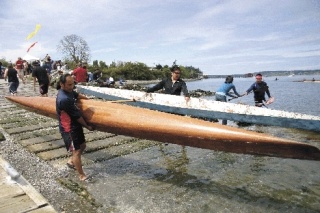A higher-than-average number of Native American competitors from around Washington and British Columbia came to race long, decorated canoes around the waters of Penn Cove Saturday.
The annual Penn Cove Water Festival drew over 3,000 people to a sunny, downtown Coupeville as Northwest tribes paddled to shore for a day of canoe races, dancing and storytelling.
“In the number of canoe clubs and people at the whole event, the turnout was great,” festival organizer Susan Berta said. “The streets were just mobbed.”
Coupeville’s water festival is one of the few non-tribal sponsored events on the canoe circuit. It was revived in 1992, after World War II brought an end to the original races.
Local tribes were honored with a greeting from Mayor Nancy Conard and a dinner with the town council to celebrate the racers’ victories.
“Although it takes tribes longer to get here and they earn less money in the races, they say they like coming back to Coupeville because we treat them so well,” Berta said.
Many canoe pullers said they had fathers and grandfathers who raced in Coupeville, which made their return a real tradition.
June Point of British Columbia’s Chilliwack Indian Tribe said she began competing in canoe races when she was 13 years old. Today she is 32.
“I trained every night for this,” said Point, who raced in the 11- and six-man canoes. “We would go out for a couple of hours at a time.”
Some tribes begin training as early as January, in what can be freezing conditions and rough seas.
By Saturday afternoon, the Coupeville Wharf was crowded with visitors who watched as teams tackled a one-third mile course from the boat launch at Captain Coupe Park.
Volunteer Howard Garrett was viewing the races from a committee boat near the start-line.
“You could hear pullers chanting as they were synchronizing from left to right,” Garrett said. “The water was so calm that I could even hear the drums from the stage on Front Street.”
In the afternoon, he saw two six-man canoes collide, forcing one team to quit the race. And later an 11-man canoe capsized, but the team was able to flip it over, bail out the water and cross the finish line.
The races continued until about 6:30 p.m.
Downtown, Berta said the festival had more Native American art vendors than ever before. Linda Silvas of the Juaneno Band of Mission Indians was selling Native drums made from animal hides. Other booths included beaded shawls and carved canoe paddles.
Small children were seen stringing along wooden boats that they created at the children’s activities tent by the Coupeville Recreation Hall, and testing them at the shore.
Berta said that over her 18-year involvement with the festival, one of the most exciting things was watching the racers as they age.
“To see the people who were in the little, junior buckskin races now entering the adult races, is really neat for me,” Berta said. “It’s great to see them grow up and I truly appreciate them coming to Coupeville.”


